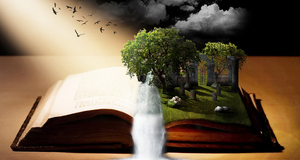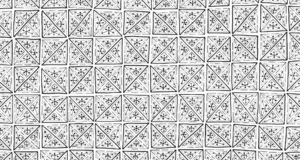Exploring the Nature of Existence: An Analysis of Wallace Stevens' The Plain Sense of Things
By
2013, Vol. 5 No. 01 | pg. 2/2 | « In the fourth stanza, the speaker’s tone begins to shift. The opening lines read “Yet the absence of the imagination had/Itself to be imagined” (13-14), and the sudden understanding of the speaker is tangible, with “Yet” signaling this moment of realization. Once again, the speaker shifts away from imagery and delves into philosophical concepts. The argument here expands on the idea first introduced to the reader in the second stanza: cause and effect—the law upon which humanity bases an immeasurable amount of knowledge—cannot be traced indefinitely backward through time, because at some point something must have been caused without an effect. How else can the concept of time be reliable, if not with a defined starting point? After jolting the reader’s thought process, the speaker then tempts the reader with “The great pond,” propelling the reader onto the next line in the hopes of finding some illuminating information to aid in explaining the previous sentence. Instead, lines fifteen and sixteen offer up “The plain sense of it, without reflections, leaves,/Mud, water like dirty glass, expressing silence” (15-16). For a second time, the reader’s mind is drawn back to a previous section of the poem: this time to the first stanza. The circular way in which the speaker highlights these concepts is reminiscent of the concepts themselves, which are frustrating due to their tautological nature. The sibilance of both lines—sixteen especially—serves to emphasize the silence and still water, and the musicality of “dirty glass, expressing silence” is sleek and pleasant. The use of the word “reflections” is interesting here; the immediate understanding of the word relates to the surface of the “great pond,” but the comma after “reflections” has the reader to pause for a moment, allowing the secondary meaning—a period of rumination after an event—to rise briefly to the surface. The repetition of “plain sense” reminds the reader just what it is s/he should be thinking about; this “great pond” should form in the mind’s eye as unembellished, “without reflections” or any other distracting adornments. All that is left are the most basic pieces from which a pond is created: mud and water. Much like “plain sense,” the leaves here recall the first stanza, reminding the reader that the end of the imagination comes “After the leaves have fallen;” that is, after the distractions and diversions of life are cast aside. The last line, “Mud, water like dirty glass, expressing silence” ushers the reader into the next stanza, with a slowing spondee followed by a pyrrhic foot, and finally four trochaic feet, whose steady rhythm soothe the reader and allow the pleasant sounds of the line come into focus. Once a pattern such as this is established, the reader comes to expect that the rhythm will continue on in the same way and this, along with the enjambment at the end of the line, swing the reader into the final paragraph.At the very start of the last stanza, the first three words qualify the “silence” from the end of line sixteen with “Of a sort, silence of a rat come out to see” (17), which completely changes the feeling of line sixteen. “Of a sort” insinuates that this silence is not true, that instead the air is full of something like white noise, or unseen activity—in this case, the stirrings of “a rat come out to see” (17). The three unstressed syllables after the first stress of “silence” create space for that quiet before the stress of “rat:” the animal in the poem is responsible for disturbing the stillness of the pond, and the word in the poem is responsible for ending the relaxed rhythm of the line. Line eighteen, in describing “The great pond and its waste of the lilies” (18) uses the definite article “the” for both pond and lilies; this creates a specific pond, with specific lilies, for the reader; the use of these definite articles constructs a specific and existing place, rather than an imagined, theoretical pond. The speaker is already describing some major philosophical abstractions; using a fixed point in the universe to facilitate the reader’s understanding is essential in communicating such theories. The end of line eighteen begins the last rushing piece of this final sentence, as “all this/Had to be imagined as an inevitable knowledge,/Required, as a necessity requires” (18-20). The sound quality of line four is recalled in line nineteen, with “imagined as an inevitable” (19) containing the “in” of both “imagined” and “inevitable” as they lay along either side of “an,” creating a softer echo of the poem’s previous assonance. The rhythm in these last few lines rushes toward the end, as the number of stressed syllables decreases from the spondee of “all this” to repeated pattern of trochaic and pyrrhic stresses in “Had to be imagined as an,” toward the iamb, pyrrhic, iamb, and lone unstressed syllable of “inevitable knowledge.” The clusters of unstressed syllables move the eye and internal voice smoothly along the line, and the frequency of unstressed syllables increases in the last line, “Required, as a necessity requires” (20). These final lines firmly separate from convention, with strings of unstressed syllables and no clear rhythm; much like the earlier descriptions of the house, where the rhythm became compounded and erratic, this last stanza breaks firmly away from the pattern of iambic pentameter found in earlier pieces of this poem. The rhythm of this poem as a whole is interesting to note. The first stanza is calm and regular, with four stresses per line, and a fairly even pattern of unstressed syllables. In the second stanza the pattern shifts and the frequency of stressed syllables increases from four in the first line, to five in the second and third and six in the fourth; the third stanza has six stresses in its first line, and line ten of the poem manages to contain seven stresses. This is the twenty-line-poem’s midpoint, toward which the rhythm ascends during the first half, and away from which the number of stresses decreases during the second. This rhythmic pattern highlights the two main images of the poem: the momentum of the poem builds toward this midpoint—focusing stresses on the descriptions of the crumbling house—and dips slightly to plateau in lines fifteen through seventeen before dropping off sharply in the last two lines, placing the focus on the great pond. The use of rhythm to focus on specific moments is one of the ways in which this poem holds the reader in the present. The tense of the poem is also crucial in communicating this feeling of an eternal moment, as the both the past and present perfect tense are employed in this poem: in all variations of perfect tense, the auxiliary verb “to have” gives forward momentum to past events, indicating that there are present consequences. Indeed, this whole poem is the speaker’s reflection on the past events that have led to this present state of contemplation and wonder: one of this poem’s main themes is the idea of existence’s “starting point,” and the most crucial thing this tense communicates is the importance of previous incidents. One of the greatest ironies present in this poem is the failed “fantastic effort” of creativity, and not only its failure but its repeated failure, “repetition/In a repetitiousness of men and flies” (11-12). The repetition of this failure does not necessarily mean that imagination has ended before; rather, that this idea has existed before. That is, “the absence of the imagination/Had itself to be imagined” (13-14). It is almost impossible to imagine a time in which imagination is no longer active, when knowledge does not lead to new insights—the fact that the speaker proposes this idea is ironic in and of itself, because this new idea proposes a time where no new ideas exist. The themes of circular motion and repetition in this poem are reflected in the speaker’s repetition of “plain sense” and the focus on cause and effect in both halves of the poem. The rounded patterns in this poem can be found in the first line: “After the leaves have fallen, we return” (1). Returning means that we have been here before—the idea of “an end of the imagination” (3) is not a new one, we’ve simply forgotten. We’ve moved away from “a plain sense of things” for a while, and are now returning, “After the leaves have fallen;” that is, after the petty struggles of life are no longer. At times the poem feels almost like a proof; preceding ideas are combined with new corollaries to strengthen and reaffirm the main themes of the piece. This circuitous pattern steadily builds the poem upon itself, returning to previous moments in order to cite them as evidence. This separation from life is steadily communicated through the bare imagery of the poem, and the focus on intellectual concepts. The few sensual descriptions in the poem are minimalistic: a vast majority of the descriptions are visual, and the only auditory description is the silence of the great pond. Instead of focusing on the sensory world, the speaker instead explores his/her own thoughts in deep detail, questioning poetry’s traditional purpose—exploring the human experience through simile and metaphor—and moving toward a poem that is almost completely within the speaker’s mind. The lack of sensory descriptions in this poem disconnects the speaker and the reader from the natural world; a fitting experience for a poem that deals with such cerebral concepts as existence and consciousness. Wallace Stevens dives into deeply metaphysical ponderings in “The Plain Sense of Things,” questioning human perception and the nature of existence through repetition and stark imagery and diction, using rhythm and meter to impress crucial detail upon the reader. The tone throughout this piece is cool and detached, holding reality at a distance in order to isolate and investigate the philosophical implications put forth. The imagery that exists in the poem is largely decaying or unpleasant; the house in stanzas two and three is crumbling, the only animals described are flies and rats, and even lilies are described as a “waste,” making the physical world feel as if it is already too far gone to be worthwhile, in a time when the omnipresence of imagination is being called into question. The focus on intellectual and philosophical concepts makes this poem stand out as a work of Wallace Stevens, whose poetry frequently centers on the metaphysical, rather than the physical world. The balance between reality and imagination is tenuous throughout the piece—an aspect of the poem which Stevens navigates with confidence and skill. But this is not only a delicate balance; it is also mercurial, as the imagery the speaker employs to communicate his/her perceptions of the nature of existence and consciousness feel as though they have been extracted from the speaker’s imagination—much like the ideas these images are being used to illuminate. This poem questions the way we perceive imagination, and suggests that maybe the creative nature of humanity is not a given; one day, new ideas might no longer take form, dooming humankind to a steady demise. The arts provide us with outlets for our creativity and imagination, creating space for the exploration and expression of new ideas. Adaptation is crucial to survival, and without a way to change or imagine new directions for ourselves, we are slated for extinction. ReferencesStevens, Wallace. 1954. "The Plain Sense of Things." http://www.poets.org/viewmedia.php/prmMID/22173 Suggested Reading from Inquiries Journal
Inquiries Journal provides undergraduate and graduate students around the world a platform for the wide dissemination of academic work over a range of core disciplines. Representing the work of students from hundreds of institutions around the globe, Inquiries Journal's large database of academic articles is completely free. Learn more | Blog | Submit Latest in Literature |














